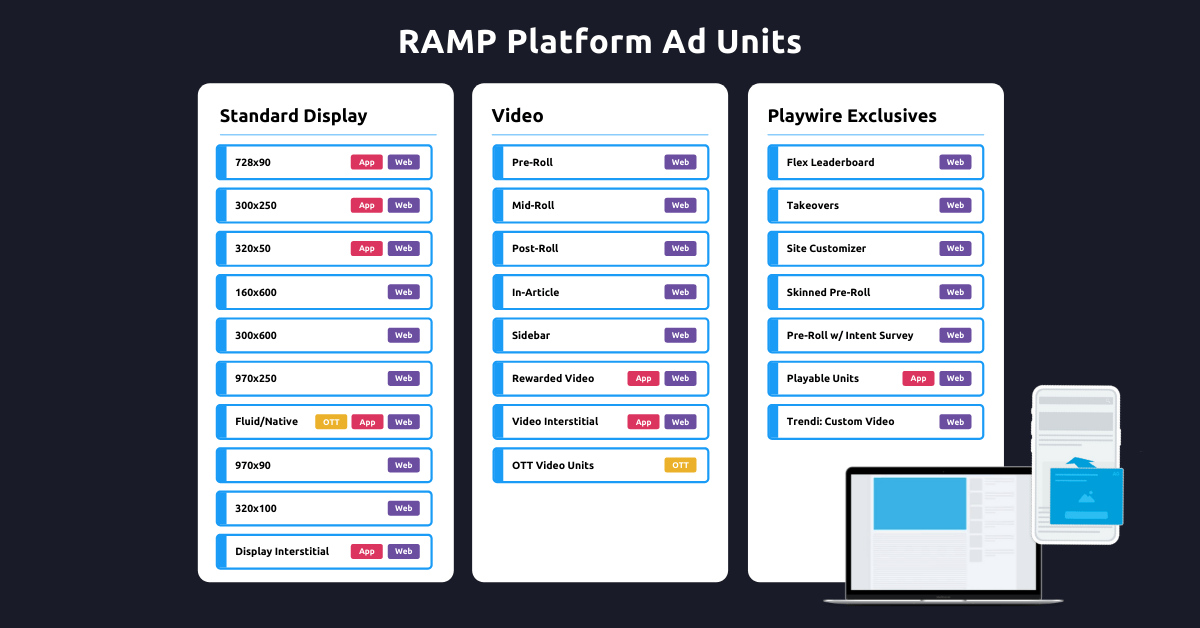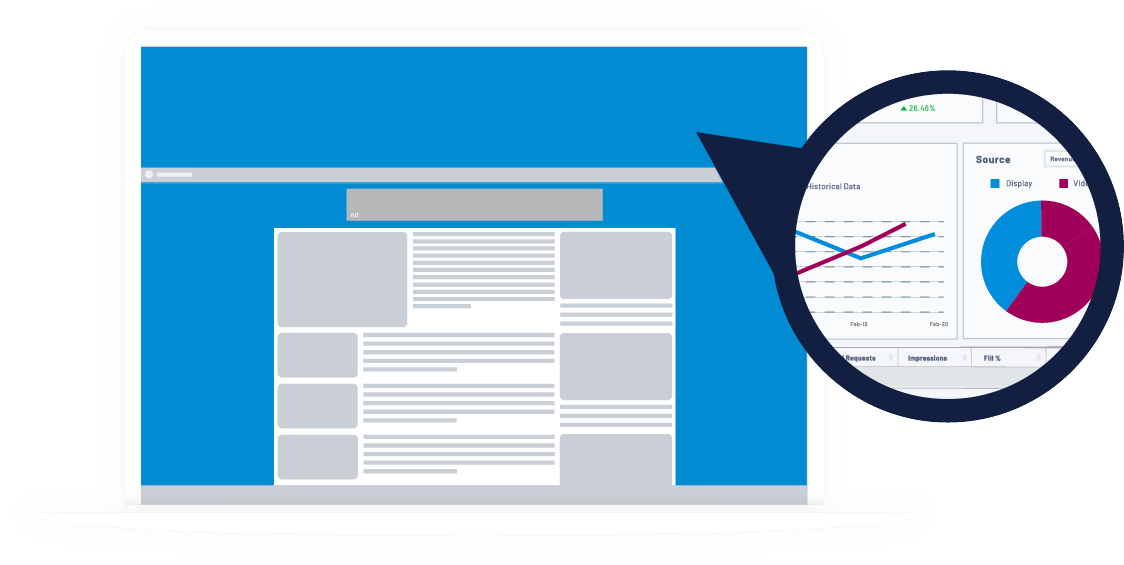THE COMPLETE GUIDE TO AD MONETIZATION
Get a PDF copy of the guide using the form below, or scroll down to read the entire guide right on this page.

Don't Have Time To Read the Entire Guide Now?
We'll email you a downloadable PDF version of the guide and you can read later.
All of our content is generated by subject matter experts with years of ad tech experience and structured by writers and educators for ease of use and digestibility. Learn more about our rigorous interview, content production and review process here.
Built with the expertise of:
Introduction
So you've got a website (or a mobile app) that has plenty of eyeballs looking at it on a regular basis, and you're considering monetizing those eyeballs.
First of all, let us just say congratulations! You are on the precipice of a very exciting time, and there are a wealth of options out there for how to most efficiently and effectively monetize your digital property!
This particular guide is meant for helping you make your first steps into building your ad monetization strategy. So if you are more seasoned, and looking for deeper details on how to optimize your revenue (rather than just getting started), you may want to take a look at some of our other, more technical content.
So with that out of the way, let's jump into how to start the process of monetizing your digital property! Keep in mind that this is a huge topic, and we are just scratching the surface, so we've provided some additional resources at the end for you to continue to dive deeper. And, as always, if you have any questions on monetizing your website or app, our experts are always happy to provide you with advice (All you have to do is ask!).
This discussion of what to consider when beginning your ad monetization journey can overall be broken down into a couple of different categories of information. Keep reading to learn more about each category of information.
This guide is meant to simplify the concept of ad monetization for publishers. It’s an extension of what we do at Playwire: We make ad tech simple for publishers so they can focus on content creation while their revenue soars. Want in on that? Contact us.
Table of Contents
What is an Ad Monetization?

Ad monetization is the practice of taking the existing traffic you drive to your website or digital property and monetizing that traffic by presenting advertisements to those viewers in exchange for payment from advertisers.
Ad Revenue Strategies

Most digital properties will fit into two categories with respect to how they structure their ad revenue strategy: advertisements as primary income and advertistments as supplemental income.
Advertisements as primary income
The first category is websites or apps that monetize solely off of advertising income. They have no other methods by which they collect revenue other than advertising. A primary example of this would be a content website whose sole purpose is providing editorial content to viewers.
Advertisements as Supplemental income
The second category is websites or apps that have a separate method of generating revenue that supports their business and advertising provides additional income on top of that. Examples of this model might include eCommerce websites that generate revenue from product sales or apps that charge for purchase to add to their existing revenue streams.
Which Model is Right?
Determining which model you will follow may affect your decisions on how to monetize ads or what you want your user experience to support, so it is important to know which camp you fit into.
Suppose you expect advertising to be your primary source of revenue. In that case, you'll likely find that your users are far more comfortable with advertising being a part of the user experience as they are getting value from you for free. Thus, you may be willing to be a bit more aggressive in the use of advertising across the site.
On the flip side, if you are using advertising as only one avenue for monetization, you'll want to be far more careful about having advertising interrupt the user journey that would lead to a visitor creating revenue in another manner (e.g. purchasing a product or subscribing). As such, you'll likely be more conservative in your use of advertising across your digital property.
There are other revenue strategies you may consider like cost per action (CPA) marketing, also known as affiliate marketing and subscription models. These are more advanced strategies which we will cover in future articles.
Types of Ad Units

There are upwards of hundreds of different types of ad formats out there across different platforms and tools, so this is far from an exhaustive list. Instead, this list seeks to provide an overview of the most common categories of ad units as a brief introduction. The categories of ad units detailed below are all relatively easy to deploy, and their status as "standard units" means a lot of advertisers are already creating ads that fit these specifications.
Depending on which platform you use, or the ad monetization partner you work with, they'll be able to provide you with a complete and comprehensive list of the ad units they have available to you directly. For instance, here is a list of the ad units we offer our customers when they choose to partner with us.

Takeover Ads
DESKTOP | MOBILE

Takeover ads are just like they sound from their title. They essentially take over the visitor's entire screen experience and are usually animated, video-based or immersive in some way.
What's important to note from a user experience perspective, is that these ads typically don't interfere with the primary content sections of a site, or with the navigation. They may instead leverage unused "gutter" space along the sides of a site, in the background, along with areas designated for banners.
Banner Ads
DESKTOP | MOBILE

Banner ads can come in various sizes and are usually static or animated images that have the option to click through to a landing page. Advertisers can use banner ads to show a call to action, or simply build brand awareness.
You can select various banner ad sizes that may fit at various places in your content, at the top of pages, or in the sidebar of your website. You can also specifically choose banners of varying shapes and sizes for different types of pages on your website to better fit with the type of content on that page.
Sticky or Adhesive Ads
DESKTOP | MOBILE

These types of ads will stick in place (often in the bottom corner or along the sidebar) as the user continues to scroll down the page. This often looks something like the following examples (where the ad unit is shown in blue as the user's scroll behavior is mimicked).
Video Ads
DESKTOP | MOBILE

Video ads have recently become some of the most popular (and not to mention profitable!) types of ad units for publishers to use. They come in three major flavors: video ads within video content, video ads interspersed in traditional written content, and rewarded ads or incentivized video.
Video ads that are incorporated into existing video content may start pre-roll, mid-roll, or post-roll, and act as “commercial breaks” to existing video content. Video ads incorporated into traditional written content will be interspersed throughout the content at various points that may look something like the example below. Such "in-article video" ads are valuable ways for publishers to leverage high-value video advertising even if you aren't creating your own video content.
App Monetization
If you have a mobile app, you'll have a different set of considerations and ad units to think about when building your ad monetization strategy. Learn more about mobile advertising, how to monetize an app with ads, or visit our comprehensive app monetization resource center.
How to Get Started
Ok great, all this information is awesome. But, how do I actually get started? There are hundreds of different ad tech tools on the market, but getting started with the basics is always a good first step.

The simplest first step is to sign up with a major ad server like Google (which something in the neighborhood of 90% of websites use for ad monetization).
You can get set up initially with Google AdSense but we'd really recommend going bigger with Google Ad Manager to truly get the value from the tool, which will connect you with Google's full ad network. If you are only using Google AdSense to get ads on your page, you will be missing out on a lot of opportunities for revenue.
And, if you are an app publisher, you'll probably want to start with something like MoPub.
These tools are great to get your feet wet and start to understand how things work. They also have great tools for learning how to use the platform and taking a DIY or self-setup approach.
As you grow, you'll want to find ways to incorporate more sources of demand in order to increase your advertising revenue. At that point, you may look more toward solutions like header bidding or Amazon TAM. Usually, when starting to incorporate tools like this, you'll want your site to have reached about a million page views per month or more to make it worth your while.
Yet another step in maturity is the choice to introduce direct ad sales into your ad monetization strategy, which you can learn more about in the "Programmatic vs. Direct Demand" section below.
No matter your current level of sophistication, you'll always find that DIY solutions you manage yourself will involve a lot of manual work. Ultimately you'll find that you can derive more revenue if you invest more time.
As you embark on this journey, you'll soon find that you need to devote more time than you have, forcing you to hire more team members, and thus diluting the impact of the revenue you are earning through advertising. At some point, you'll find yourself at a tipping point where you can scale revenue more effectively by outsourcing the work to a professional ad monetization platform.
Choosing the right ad monetization platform can truly help increase ROI and reduce the complexities of monetization.
Privacy and Legal Requirements

The other major consideration you’ll need to spend time on is your privacy policy. When adding advertising for the first time, you can expect that you’ll have to make some major revisions to your policy to fit with the level of data you are sharing with your advertising partners.
In addition, you need to make sure you are correctly controlling the data passed to advertisers when dealing with EU citizens. This typically requires a technology solution like a consent management platform (CMPs).
Additionally, if you have content geared toward children, you’ll also want to make sure you research the Children’s Online Privacy Protection Act (COPPA) before adding any advertising to your website.
The good news is that a professional monetization partner can help you with all of the above. However, if you are a kids' site with COPPA concerns, make sure you confirm that the partner has experience working with COPPA compliance, as not all do, and making a mistake here can have legal and financial ramifications.
Optimizing Revenue Generation
As you become more sophisticated, you’ll start looking for ways to optimize the revenue your website can generate. And there are a few things you’ll want to be aware of as you dive in.
There are two major audiences you have to consider as you start this process: your visitors (or users if you are an app publisher) and your advertisers.
Visitor/User Needs
First, you need to think about what your users want from your content. Your users and visitors must be your guiding light because without them advertisers aren’t going to be interested in paying you.
Your primary goal needs to first be keeping (and increasing) your number of users or visitors, and making them incredibly happy.
Ad Quality
How this relates to advertising is in the realm of ad quality. You will want to be incredibly careful about ensuring that content you wouldn’t want your users to see doesn’t pop up in the ads you display on your website.
Understanding how picky you are on what content is allowed from advertisers is entirely based on how picky your audience would be, or how picky you are in how it affects your own brand.
And the most important thing to think about is how difficult it will be to keep that content off your site with the more DIY-style tools we discussed above. Using category blocks will help you wall off very large categories of content, but the more nuanced you want to be in the rules you employ, the more difficult it will be to ensure high-quality ad content.
Customer Example: As a very clear example, one of our customers is a producer of content specifically aimed at children and their brand has a very clear “no gun-play” stance on the ads shown on their website. This is actually incredibly hard to achieve with standard category blocks as many ads labeled “safe for children” as a general rule may have things like nerf guns displayed in them. As such, they needed a more sophisticated and curated method for managing the quality of ads displayed on their website.
Advertiser Needs
If yours is a hobby site that doesn’t have to pay the bills, that may be fine for you, but you may have other, grander goals that will dictate when and how to start earning ad revenue. Here are some of the common goals of today’s publishers, each of which necessitates a different ad revenue strategy:
What NOT to do:
This leads us right into a quick list of “what not to do to make advertisers mad.”
Avoid “fakeness.” In general, avoid doing things that “inflate” your numbers in an effort to make more money. This might look like making fake content that ultimately gets blacklisted or trying to find ways to produce fake views of your pages. This also covers tricks to try and get users to click on ads because they think it is something else.
In general, just stay away from things that feel like “tricks” because advertisers can sniff them out very quickly and you’ll lose credibility.
What to do:
On the flip side, there are some other things you can do that will make advertisers very happy.
Focus on a specific audience. Trying to be everything to everybody doesn’t help advertisers target their ads to the right people. Websites that go after a very specific audience (like young parents for instance) are going to present opportunities for advertisers to pay a premium to get in front of their desired audience.
Focus first and foremost on creating premium content, and the advertising will come. The happier your users are, the more visitors you get, the more views your ad units will have, and the more advertisers will pay for them. So basically, making visitors happy will make advertisers happy.
Metrics to Watch

This all sounds great, but how do I know if I’m making visitors and advertisers happy?
Luckily there are some metrics that will help you see if you are on the right track. Remember, your web or mobile ad monetization strategy will be all about making your supply as attractive as possible to advertisers, and the following metrics give indications of just that:
- Click-Through Rate (CTR): the percentage of ad impressions (or views) that result in a click-through to the advertiser landing page.
- Viewability Rate: the percentage of ads on a page that are actually viewed by the user (e.g. if an ad is on the lower half of a page and the user never scrolls to see it). An ad will be counted if at least 50% of the ad was displayed on screen for at least one second for a display ad or two seconds for a video ad.
- Video Completion Rate (VCR): the percentage of video ads that were viewed until the end of the video.
Some additional metrics to keep track of, based on user engagement, can help you understand how your user experience is performing:
- Session depth: the number of pages viewed by a user in a single session. The higher this number, the more ad unit views from a single visitor.
- Session length: the amount of time a user spends on your website. Again, the longer the user is on the site, the more ad units they will have the opportunity to view.
- Sessions per user: the number of times a visitor returns. This is a great measure of the quality of your content. The more repeat visitors you have, the more you will make per each unique visitor in terms of ad revenue.
You’ll find that there are various techniques you can test to see their effectiveness in improving these metrics, and ultimately your yield. They may include things like:
- Adjustments to ad layouts and sizes
- Balancing the number of ads you are running (Like Goldilocks, you don’t want to run too many or too few, but just the right amount)
- Refresh rates on a particular ad unit that increase the number of engaged units you show
- Integrations with tools like MOAT can help you weed out invalid traffic (IVT)
- Optimizing existing code on your website which may be slowing you down or causing issues with IVT
- Utilizing tools that can recognize heavy ads, stop them from running, and ensure you aren’t sacrificing revenue
Programmatic vs. Direct Demand
This is a pretty advanced topic, so we won’t be diving too deep into it here, but we’d be remiss if we didn’t at least mention it.
Programmatic advertising is the traditional ad buying and selling process — digitized and fully automated. Instead of using people to buy and sell online ads, programmatic advertising uses software to do so in real-time, all the time. In this instance, advertisers bid on available ad supply through a stock exchange-style interface.
There are many kinds of programmatic buying, from preferred deals to private marketplaces to open exchanges. Different types of programmatic buying provide a range of options that, on one end, come close to traditional insertion order (IO), or direct buying experience, and on the other end are completely automated.
Often, incorporating some level of direct demand, where advertisers are searching for very specific types of websites or digital properties on which to display ads, can create significant increases in overall revenue generated. Getting access to direct demand is something that is not available through DIY tools, and is a more advanced ad monetization strategy typically executed through a monetization partner.
Different types or sizes of publishers will have different ways in which they balance the revenue coming in from both programmatic and direct-sold ads. Typically larger publishers will have a blend of both types, whereas smaller publishers just starting out may focus solely on programmatic ads.
When is it Time to Ask for Help?
If this sounds like a lot to think about, that’s because it is. Depending upon your resources, and the amount of time you have to dedicate to managing all of this, you may want a monetization partner. You should be able to get an idea of the ROI they can provide just by talking to them (and oftentimes a monetization partner will more than pay for themselves). So if this is sounding overwhelming, then by all means investigate working with one!
Additional Resources:
The Interactive Advertising Bureau (IAB) empowers the media and marketing industries to thrive in the digital economy, and they have a wealth of resources to help you get started building your ad monetization strategy.
Google’s Publisher Solutions allow you to explore Google's complete suite of products designed to help you get the most from your content.
Related Content
Feel free to visit our Complete Ad Monetization Resource Center, or dive deeper into any of these related articles:
- What is Ad Monetization?
- Best Ad Monetization Platforms in 2022
- Best Ad Monetization Solutions
- How to Build an Ad Monetization Strategy
- 7 Best Ad Monetization Practices
- Ad Monetization with Playwire vs. Building Out an Ad Ops Team
- The Best Method for Video Ad Monetization
- Changing the Face of In-App Ad Monetization
- Ad Tech Stack Build vs. Buy Series: Ad Monetization Solutions
AMPLIFY YOUR AD REVENUE
Accelerate your business and uncomplicate your ad tech stack, because you deserve a partner and a platform that demands more for you.



